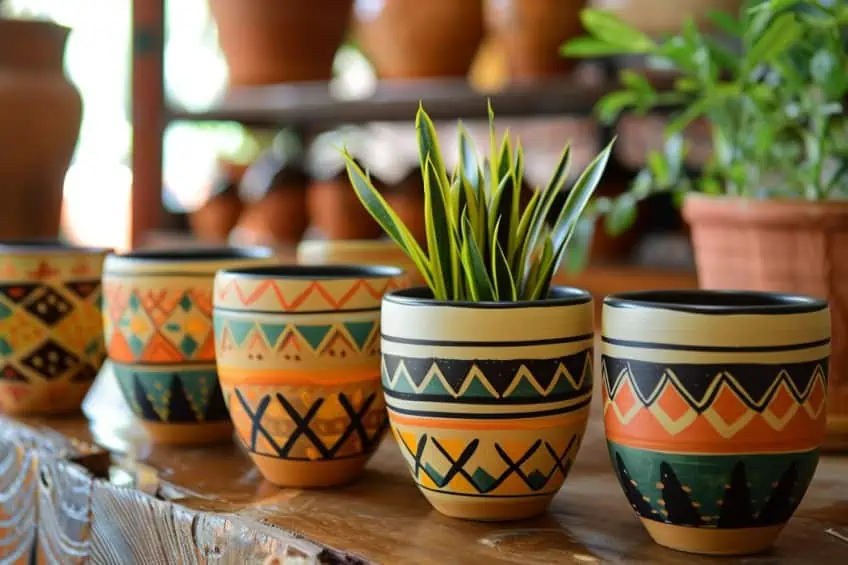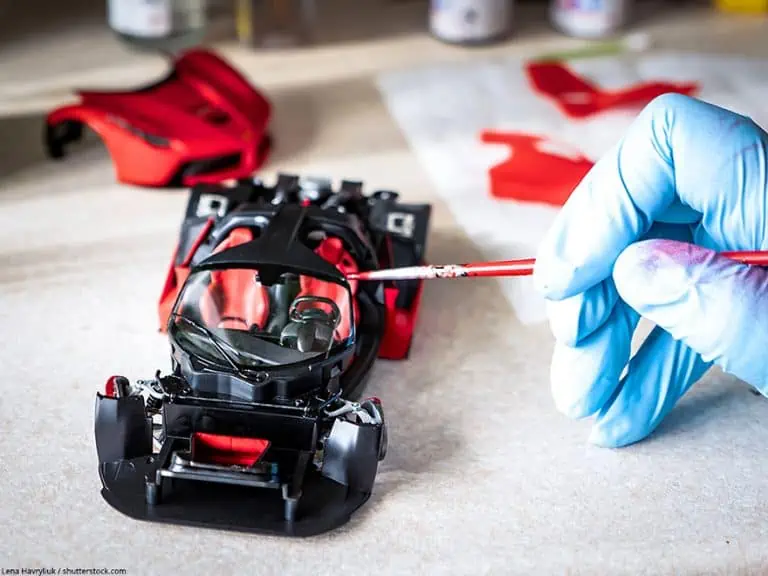How to Paint Terracotta Pots – Transforming Terracotta With Color
This post may contain affiliate links. We may earn a small commission from purchases made through them, at no additional cost to you.
Welcome to the colorful world of terracotta pot painting, where ordinary clay pots transform into vibrant masterpieces! Whether you’re a seasoned artist or a beginner looking for a creative adventure, painting terracotta pots is a fantastic way to add a personal touch to your garden or home decor. From whimsical designs to elegant patterns, let’s dive into the tips and tricks that will turn your plain pots into works of art that will make your plants pop and your guests green with envy!
Table of Contents
Key Takeaways
- Proper preparation of terracotta pots ensures optimal painting results.
- Using appropriate painting and priming techniques can enhance the durability of the pots.
- Sealant application protects the painted pots, making them suitable for both indoor and outdoor use.
Preparing Your Workspace and Materials
Terracotta pots, with their natural earthen charm, provide an ideal canvas for DIY enthusiasts looking to add a personal touch to their home or garden décor. Painting terracotta pots not only breathes new life into these classic plant containers but also allows for customization to fit any design scheme.
Before embarking on this creative endeavor, it’s essential to gather the right materials, such as acrylic or spray paints, primers, and sealants, to ensure a durable and aesthetically pleasing result.
Cleaning and prepping the pot surface is critical for paint adhesion. For those stepping into the world of terracotta painting, understanding priming techniques and using the right tools are key steps that lead to a professional-looking finish. Once primed, the pots can be decorated using various painting techniques that may include stencils, tape for creating clean lines, or even implementing unique textures or patterns.
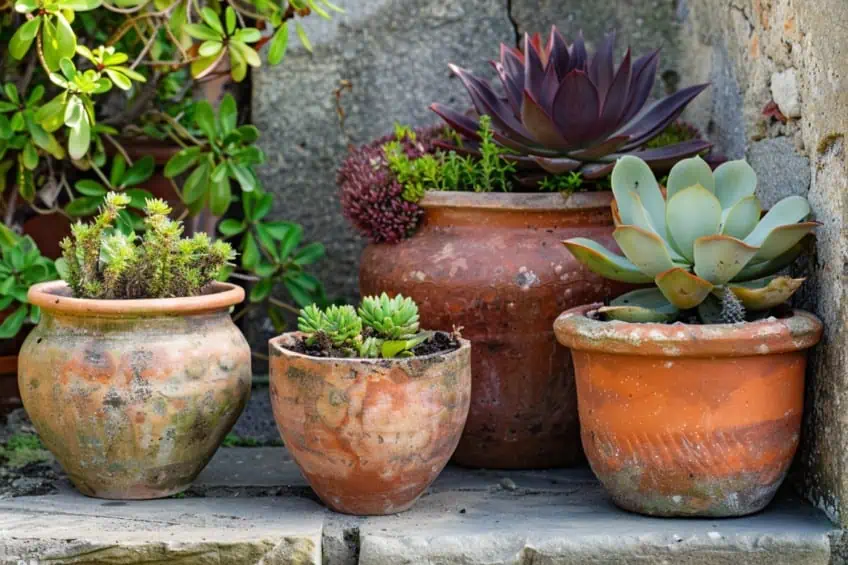
After the paint has dried, applying a suitable sealant can protect the artwork from water damage and wear, ensuring the pots are both functional and stylish. Proper preparation of workspace and materials is crucial for painting terracotta pots effectively. This involves selecting suitable supplies and ensuring the painting area is conducive to the task.
Choosing the Right Supplies
Before beginning any terracotta painting project, one must gather the necessary supplies for an efficient and successful outcome. This encompasses a selection of acrylic paints, which are ideal for terracotta due to their durability and vibrant colors. A paintbrush selection should include various sizes for base coats and detailed work. To prep the pots, sandpaper is essential for smoothing rough surfaces and primer is required to seal the clay and enhance paint adhesion.
- Acrylic paints
- Variety of paintbrushes
- Sandpaper (fine-grit)
- Primer (suitable for terracotta)
- Terracotta pots
Setting Up Your Painting Area
The next step involves establishing a clean and organized workspace. It should be spacious enough to maneuver around the pots and have ample lighting. A drop cloth or old newspapers should be spread out to protect the surface from spills and drips. Ensuring the area is well-ventilated will safeguard against inhaling fumes from paints or sealants. The workspace should be arranged to keep all materials within reach but also out of the way to prevent accidents.
- Spread out a drop cloth or newspapers.
- Confirm good lighting and ventilation.
- Arrange supplies for easy access.

Priming and Painting Techniques
In painting terracotta pots, one must ensure proper surface preparation and use the right priming and painting techniques to achieve a durable and aesthetically pleasing finish. It’s essential to use acrylic paint for its vibrant colors and a foam brush or regular brush for smooth application.
Cleaning the Pot
Before painting a terracotta pot, one should thoroughly clean its surface to remove dust, dirt, and any oils that may interfere with paint adhesion. First, they should wipe the pot with a damp cloth and then allow it to dry completely. A clean pot ensures that the primer and paint will adhere properly and the finish will be smooth.

Applying Primer for a Base Coat
Priming terracotta pots is a critical step to prevent moisture absorption and provide a uniform base for the topcoat. An even layer of primer should be applied using a foam brush or a regular paintbrush for best results.
The primer should be given ample time to dry according to the manufacturer’s instructions before proceeding to paint.
Painting Terracotta Pots
After priming, one can begin painting terracotta pots. Acrylic paint is recommended for its color vibrancy and fade resistance. They can start with a base coat and use additional coats as needed to achieve the color depth they desire. It is important to let each coat of paint thoroughly dry before adding another to avoid any flaking or peeling of the paint.
- Tools: Foam brush or paintbrush
- Materials: Acrylic paint
- Process: Apply the first coat of paint evenly. Allow to dry thoroughly. Apply additional coats as needed

Creating Decorative Designs
For decorative designs, one has many options, such as using stencils, rubber bands, or painter’s tape to create stripes or other patterns. They should secure their stencils or tape firmly to the pot and use a foam brush or regular brush to apply paint carefully over the design. After painting, they should carefully remove the stencil or tape before the paint dries to reveal a clean design.
- Stripes: Apply rubber bands or painter’s tape to create even lines
- Stencils: Place and secure stencil before applying paint
- Dry time: Remove any guides before the paint dries
Finishing Touches and Sealant Application
Applying finishing touches and sealant to terracotta pots is critical for ensuring both aesthetic appeal and long-term durability. The pot must be completely dry before adding sealant, and a suitable acrylic sealer should be used to provide a water-resistant finish.
Ensuring Proper Drying
Before the application of any sealant, it is paramount that the painted terracotta pot is completely dry. This prevents any moisture from being trapped under the sealant, which could potentially lead to peeling or flaking of the paint over time. Depending on the thickness of the paint layers, drying time can vary, but it is generally recommended to wait at least 24 hours after the last coat.
- Allow the final paint coat to dry for a minimum of 24 hours.
- Check the surface by gently touching it; it should not feel tacky or sticky.
- Place the pot in a well-ventilated area away from direct sunlight to aid in the drying process.

Sealing for Durability
Sealing is the final step to protect the painted surface from wear and tear as well as weather elements if the pot will be used outdoors. A clear acrylic sealer, preferably a waterproof sealant, is an ideal choice. These sealants come in various finishes—glossy, matte, and satin—to match the desired look of the painted pot.
- Choose an acrylic sealer that is suitable for outdoor use if the pot will be exposed to the elements.
- For a uniform coat, use a spray sealer, applying it in thin, even layers to avoid drips.
- Apply multiple thin coats rather than a single thick one, ensuring each layer is dry before applying the next.
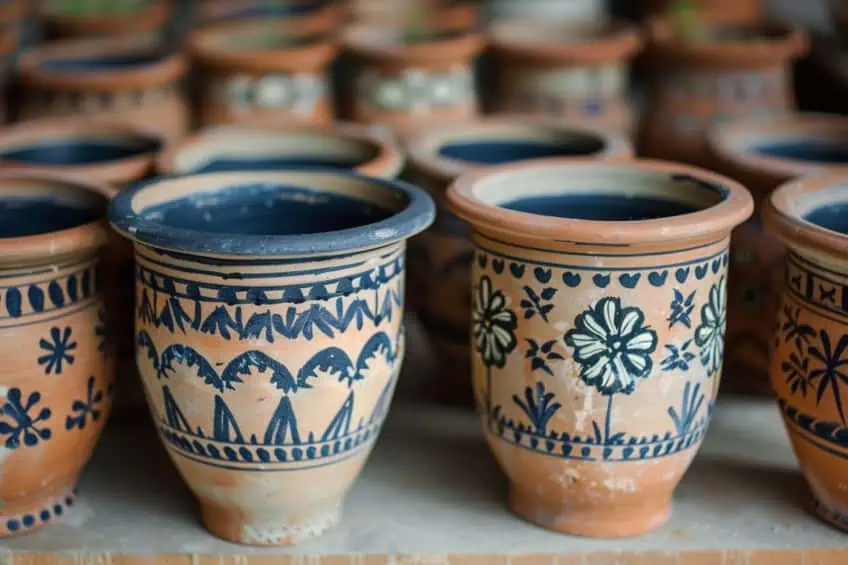
A well-applied sealant not only enhances the water-resistant properties of the terracotta pot but also helps maintain the vibrancy of the paint over time.
Displaying and Using Your Painted Pots
Once the painted terra-cotta pots are dry and sealed, they are versatile additions to any gardening or home decor setup. These pots can enhance the aesthetic of a space, whether used as a container garden or as a standalone decorative piece.
Indoor and Outdoor Considerations
When using terracotta pots indoors, consider their unique benefits. Their porous nature can regulate soil moisture, making them ideal for indoor plants that thrive in drier conditions. To protect your furniture, place the terracotta pots on a waterproof saucer, ensuring that any excess water doesn’t cause damage. This combination of climate adaptability and strategic placement enhances both the health of your plants and the longevity of your indoor spaces.
For outdoor use of painted terracotta pots, prioritize their durability against the elements.
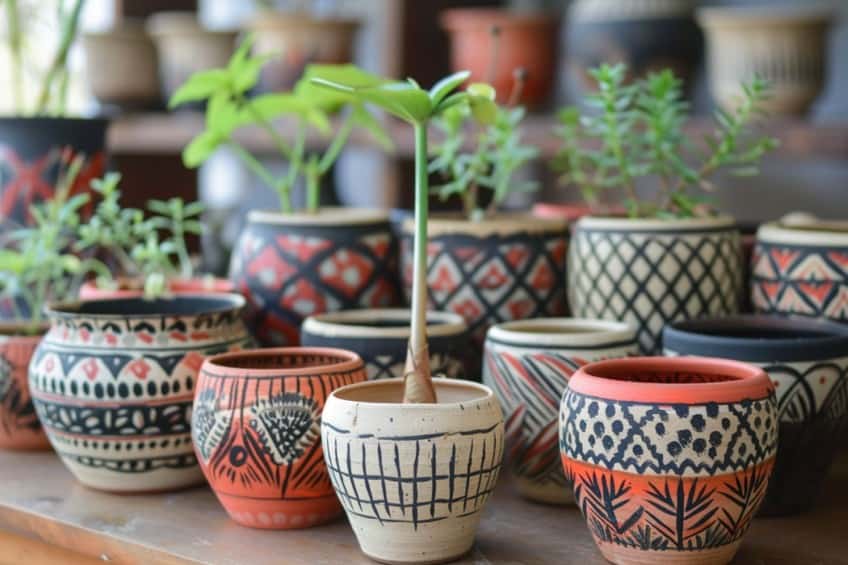
Use a sealant that’s specifically designed for outdoor conditions to protect the paint from weather-related wear and tear. When placing the pots, opt for locations that not only enhance your outdoor aesthetic but also shield them from extreme weather, ensuring that your painted creations remain vibrant and intact for a long time to come.
Gifting and Home Decor Ideas
When considering painted terracotta pots as gifts or for home decor, personalization and coordination are key. For gifting, customize the design to the recipient’s preferences, making it a thoughtful and unique present. In terms of home decor, coordinate the pot’s colors and patterns with the room’s accents to achieve a cohesive aesthetic. Experiment with grouping pots of different sizes but similar designs to create an eye-catching focal point that adds character and charm to any space.
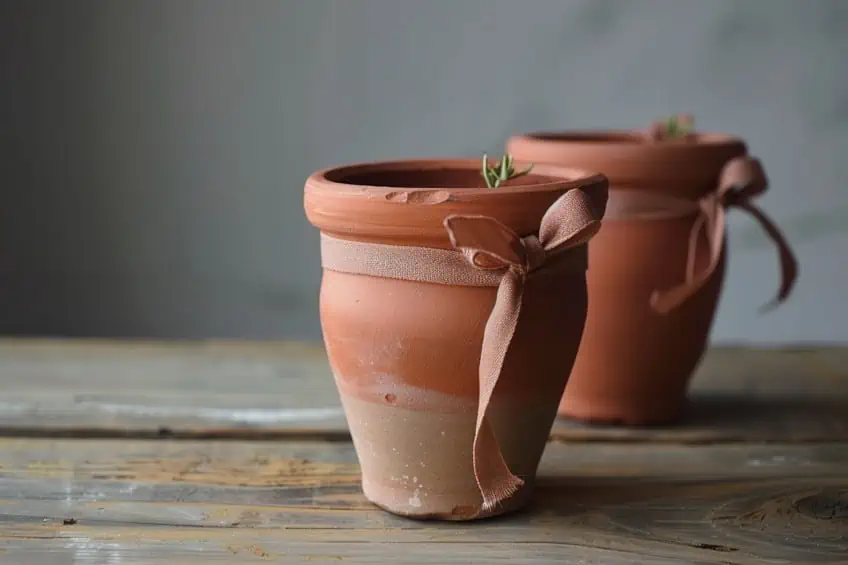
As you put the finishing touches on your painted terracotta pots, take a moment to admire the transformation you’ve created. Each brushstroke and splash of color reflects your unique style and creativity. Now, display your botanical buddies in these personalized pots and watch as your garden or indoor space bursts to life with personality and charm. Happy painting, and may your plants thrive in their newly adorned homes!
Frequently Asked Questions
What Type of Paint Is Best for Outdoor Terracotta Pots?
For outdoor terracotta pots, acrylic paint is typically the most suitable owing to its durability and bright color palette. It withstands the elements better than other types of paint and is less prone to fading under sunlight.
Is It Necessary to Apply a Primer Before Painting Terracotta Pots?
Yes, applying a primer is crucial before painting terracotta pots. Primer acts as a protective layer that helps the paint adhere better to the pot and prevents peeling. It also provides a uniform base for the paint to reveal its true color.
Does Painting Terracotta Pots Affect Their Porosity and How?
Painting terracotta pots does affect their porosity. Terracotta is naturally porous, which aids in the aeration and moisture regulation of the soil. When one paints it, that layer of paint can seal the surface, reducing its breathability and altering the moisture levels within. This is important to consider for the health of the plants they house.
In 2005, Charlene completed her wellness degrees in therapeutic aromatherapy and reflexology at the International School of Reflexology and Meridian Therapy. She worked for a company offering corporate wellness programs for several years before opening her own therapy practice. In 2015, she was asked by a digital marketer friend to join her company as a content creator, and it was here that she discovered her enthusiasm for writing. Since entering the world of content creation, she has gained a lot of experience over the years writing about various topics such as beauty, health, wellness, travel, crafting, and much more. Due to various circumstances, she had to give up her therapy practice and now works as a freelance writer. Since she is a very creative person and as a balance to writing likes to be active in various areas of art and crafts, the activity at acrylgiessen.com is perfect for her to contribute their knowledge and experience in various creative topics.
Learn more about Charlene Lewis and about us.
